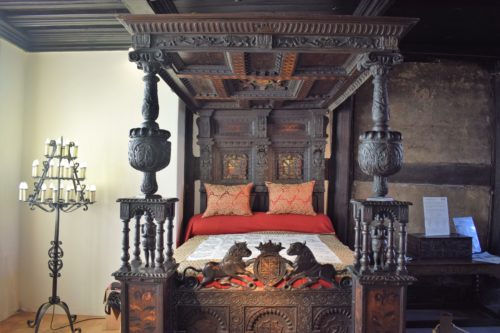Last week I took some time out, met up with some friends and took a tour of Ordsall Hall in Salford. I’d been once before, during the summer to one of their outdoor theatre events. I’d had a very quick look around, but I knew I had to go back and have a proper look. I was not disappointed.

Ordsall Hall is a Grade 1 listed Tudor manor house which was first recorded in 1177. Since then, it has been home to Medieval and Tudor nobility, butchers, farmers, and Earl, an artist, priests, mill workers, cows and even several ghosts! It has an incredibly rich history and as a result is a fascinating family museum. There are rooms laid out as they would have been many hundreds of years ago, a cafe and some absolutely stunning organic gardens.
When you first enter the grounds, you’re greeted with the sight of the stunning Tudor manor house. There are quatrefoils (the white motif which looks like four circles overlapping) covering much of the exterior and lots of ancient carvings in the woodwork. The detail carries on inside.

From the reception area, you walk into the impressive Great Hall, which is a glorious space. The walls are covered with original wooden paneling, the windows include a stunning oriel window which dates from around 1600. There are also two huge but relatively modern windows which were installed in 1897 by the then owner, Earl Edgerton of Tatton.
From the Great Hall, you can explore the Star Chamber, a bedroom with an intricately carved four poster bed and a ceiling covered in brass stars. The bed itself was the wedding bed of Sir John Radclyffe. The room is quite lovely and thanks to the guides, we learned that the marks on the fireplace were where previous inhabitants had sharpened their swords.

Upstairs we were led into the Solar Room which would have been where the lady of the house slept and spent her day. As the name suggests, the room is really light and bright. There’s another four poster bed and a wardrobe full of period costume, which visitors are encouraged to try on. This room is very hands on and children especially are encouraged to explore.
Upstairs from the Solar Room what is known as the Coat of Arms Room; this is because there is a huge stone coat of arms above the fireplace. The room was originally where the wet nurse would have slept. Again, it’s a lovely light room which they’ve decorated with wallpaper recreated from a scrap they found when they were renovating the hall. Every room is heaving with history.
Along the corridor from the Solar Room is the Italian Plaster Room. This is not open to the public, but it had a glass door so you can look inside. The room is named for it’s ornate Italian plaster ceiling which dates from around 1380. The impressive geometric plaster ceiling is the work of Venetian artists and it’s incredibly beautiful.
From there we made our way to the kitchens which were constructed in around 1600. The kitchens feature recreations of the cooking implements and the food they would have prepared and eaten. This was an especially interesting part of the building because I’m interested in the history of food.

Climbing the staircase near the kitchens, you make your way to the attic where the servants would have slept. There’s a noticeable change in the temperature and quality of the original construction. There are two large-ish attic spaces, each with a small fireplace in. They most likely slept dormitory style and would have had very little personal space or privacy.
There are a number of permanent and temporary exhibitions on at Ordsall Hall. It’s well worth visiting the The Frederic Shields Gallery upstairs which has a number of interactive exhibits about the hall, its history and the surrounding area.
Outside there are formal gardens which looked neat and tidy in February, but back in the summer they were lush and very beautiful. There’s a small orchard; a WW1 garden and a lovely lush lawn which is where their outdoor theatre shows are performed.
Ordsall Hall have a full progamme of events for all ages, and regularly run guided tours of the house (£3.50 per person). You can explore by yourself, but going on the guided tour gives you so much more information and insight than you would normally. I found out so much more from the tour guides than I ever would have by just mooching around by myself.
I’m a massive fan of small hidden gems like Ordsall Hall. It’s surrounded by modern houses. If you’ve never visited before, the sight of this Tudor manor house in the middle of a fairly normal looking housing estate in Salford takes your breath away.
It’s also incredibly easy to get to on public transport. I got the tram to Exchange Quay and it’s less than five minutes walk from there. The hall and the grounds are free to visit, and it’s a real treasure. They do rely on donations, so I made sure to put some money in the donations box.
I am wowed by Ordsall Hall. I’m going back over half term with my son to take part in some activities and give him the tour. He’s already excited about the prospect of encountering one of the resident ghosts!
For more information about Ordsall Hall, visit their website.

Disclosure: Ordsall Hall is free to visit. I have not been compensated for this post; I’ve only written about it because it’s an incredible place to visit. I’m a big history lover. If you love history, you need to visit. It’s free.







